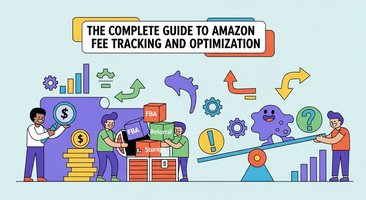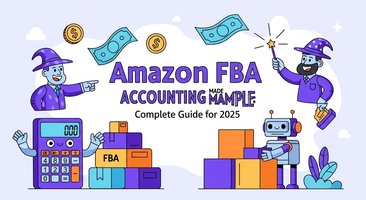Amazon Brand Registry has become essential for serious sellers looking to protect their intellectual property and build sustainable businesses on the platform. However, the costs associated with brand protection, trademark registration, and IP enforcement can significantly impact your bottom line if not properly tracked and managed.
This comprehensive guide will help you understand the accounting implications of brand protection efforts while establishing systems to track these investments and measure their impact on your business profitability.
Understanding Amazon Brand Registry
Amazon Brand Registry provides brand owners with tools to protect their intellectual property and enhance their brand presence on Amazon. While enrollment is free, the underlying requirements and ongoing protection efforts involve significant costs that require proper accounting treatment.
Brand Registry Requirements and Costs
Trademark Registration represents the primary requirement for Brand Registry enrollment, involving several cost categories:
Government Filing Fees:
- USPTO filing fees: $250-$400 per class
- International trademark registration: $500-$2,000+ per country
- Renewal fees: Required every 10 years for most jurisdictions
Professional Services:
- Trademark attorney fees: $1,000-$3,000 per application
- Trademark search services: $300-$800 per search
- Office action responses: $500-$1,500 per response
- International filing coordination: $200-$500 per country
Ongoing Maintenance:
- Renewal preparation and filing: $500-$1,500 every 10 years
- Trademark monitoring services: $200-$500 annually
- Domain name registrations: $10-$50 annually per domain
Brand Protection Investment Categories
Brand protection efforts extend beyond initial trademark registration to include ongoing monitoring and enforcement activities:
Monitoring and Detection:
- Brand monitoring software subscriptions
- Professional monitoring services
- Manual review and analysis time
- Counterfeit detection tools
Enforcement Actions:
- Legal fees for cease and desist letters
- Amazon Brand Registry complaint filings
- Customs enforcement registrations
- Litigation costs for serious violations
Brand Building Investments:
- Enhanced brand content creation
- A+ content development
- Brand store setup and maintenance
- Professional photography and videography
Accounting for Trademark and IP Costs
Intellectual property accounting requires understanding the difference between capital expenditures and operating expenses, as this classification affects both financial reporting and tax treatment.
Capital vs Operating Expense Classification
Trademark Registration Costs typically qualify as capital expenditures that should be amortized over the trademark's useful life:
Capitalizable Costs:
- Government filing fees
- Attorney fees for registration
- Search and preparation costs
- International filing coordination
Operating Expenses:
- Ongoing monitoring services
- Enforcement actions and legal fees
- Renewal preparation costs
- Brand content creation
Amortization of IP Assets
Trademark amortization spreads the initial investment cost over the asset's useful life:
Standard Amortization Period: Most businesses amortize trademarks over 15 years for tax purposes, though the actual useful life may be longer.
Calculation Method: Straight-line amortization divides the total capitalized cost by the amortization period.
Example Calculation: A $5,000 trademark registration cost amortized over 15 years results in $333 annual amortization expense.
Chart of Accounts Setup
Proper account structure for IP-related costs ensures accurate tracking and reporting:
Asset Accounts:
- Trademarks and IP Rights
- Accumulated Amortization - Trademarks
- Brand Development Costs
- Domain Names and Digital Assets
Expense Accounts:
- Trademark Amortization Expense
- IP Monitoring and Protection
- Legal Fees - IP Enforcement
- Brand Content Development
- Professional Services - IP
Brand Protection Cost Analysis
Brand protection investments require systematic tracking to understand their impact on business profitability and make informed decisions about protection strategies.
Cost Categories and Tracking
Systematic cost tracking helps identify the true cost of brand protection:
Direct Protection Costs:
- Trademark registration and maintenance
- Legal fees for enforcement actions
- Monitoring service subscriptions
- Customs enforcement registrations
Indirect Protection Costs:
- Time spent on brand protection activities
- Lost sales during IP disputes
- Inventory seizures and disposal costs
- Opportunity costs of protection efforts
Brand Building Investments:
- Enhanced content creation
- Professional photography
- Brand store development
- Marketing materials and assets
ROI Measurement Challenges
Measuring brand protection ROI presents unique challenges since the benefits are often preventative rather than directly revenue-generating:
Quantifiable Benefits:
- Reduced counterfeit competition
- Improved search ranking from authentic reviews
- Higher conversion rates from enhanced content
- Premium pricing opportunities
Difficult-to-Quantify Benefits:
- Long-term brand value protection
- Customer trust and loyalty improvements
- Reduced legal risks and disputes
- Market position strengthening
Performance Metrics for Brand Protection
Key performance indicators help evaluate brand protection effectiveness:
Protection Metrics:
- Number of successful takedown requests
- Time to resolve IP violations
- Reduction in counterfeit listings
- Brand mention monitoring results
Business Impact Metrics:
- Market share changes in protected categories
- Average selling price improvements
- Customer review quality improvements
- Organic search ranking improvements
Amazon-Specific Brand Protection Costs
Amazon's ecosystem creates unique brand protection challenges and opportunities that require specific accounting consideration.
Amazon Brand Registry Tools and Costs
Brand Registry tools provide various protection mechanisms, each with different cost implications:
Report a Violation Tool:
- Free to use but requires time investment
- May require documentation and evidence gathering
- Potential need for professional assistance
Transparency Program:
- Requires product authentication codes
- Additional packaging and printing costs
- Inventory management complexity
Project Zero:
- Invitation-only program
- Requires significant brand protection history
- May involve additional monitoring costs
Enhanced Brand Content Investments
Brand content development represents a significant investment in brand protection and enhancement:
A+ Content Creation:
- Professional design services: $500-$2,000 per product
- Photography and videography: $1,000-$5,000 per product line
- Copywriting and optimization: $200-$800 per product
Brand Store Development:
- Initial setup and design: $2,000-$10,000
- Ongoing maintenance and updates: $500-$2,000 monthly
- Content creation and optimization: $1,000-$5,000 quarterly
Enhanced Brand Content Maintenance:
- Regular updates and optimization: $200-$500 monthly per product
- Seasonal content variations: $500-$1,500 quarterly
- Performance monitoring and analysis: $300-$800 monthly
International Brand Protection Accounting
Global brand protection involves multiple jurisdictions and complex cost structures that require careful accounting management.
Multi-Jurisdiction Trademark Costs
International trademark protection creates complex cost structures:
Madrid Protocol Filings:
- Base application fees: $653-$903
- Per-country designation fees: $100-$700 per country
- Subsequent designation fees: $300-$600 per country
Direct National Filings:
- Country-specific filing fees: $200-$2,000 per country
- Local attorney fees: $500-$3,000 per country
- Translation costs: $100-$500 per application
Ongoing International Maintenance:
- Renewal fees vary by country: $200-$1,500 per renewal
- Local representation requirements: $200-$800 annually per country
- Currency conversion and banking fees: 2-5% of total costs
Currency and Tax Considerations
International IP costs involve currency and tax complexities:
Foreign Exchange Impact:
- IP costs incurred in multiple currencies
- Exchange rate fluctuations affect total investment
- Hedging considerations for large IP portfolios
Tax Treatment Variations:
- Different countries may have varying IP tax treatments
- Transfer pricing considerations for international IP assets
- Potential for IP holding company structures
Technology and Automation for Brand Protection
Automated brand protection systems help manage the complexity and scale of modern brand protection efforts while ensuring proper cost tracking.
Manual Brand Protection Limitations
Manual brand protection becomes overwhelming as businesses scale:
Time-Intensive Monitoring: Manual monitoring of brand mentions, counterfeits, and violations requires significant time investment.
Inconsistent Documentation: Manual tracking of protection efforts may lack consistency needed for proper accounting and legal documentation.
Scalability Issues: Manual processes don't scale effectively as product lines and marketplaces expand.
Cost Tracking Difficulties: Manual systems struggle to accurately track and allocate brand protection costs across products and categories.
Automation Benefits
Automated brand protection provides several advantages:
Comprehensive Monitoring: Automated systems can monitor multiple platforms and marketplaces simultaneously for brand violations.
Consistent Documentation: Automated systems maintain detailed records of all protection activities for accounting and legal purposes.
Cost Allocation: Systematic tracking enables proper allocation of brand protection costs across product lines and business segments.
Scalable Operations: Automated systems handle increased complexity without proportional increases in manual effort.
Klavena's Brand Protection Cost Tracking
While Klavena doesn't provide specialized brand protection ROI analysis, it does offer systematic cost tracking for brand-related investments:
Expense Categorization: Automatically categorize trademark, legal, and brand development costs for proper accounting treatment.
Asset Tracking: Track trademark and IP assets with appropriate amortization schedules.
Cost Allocation: Allocate brand protection costs across product lines and business segments for profitability analysis.
Financial Reporting: Include brand protection costs in comprehensive financial reporting for better business decision-making.
Best Practices for Brand Protection Accounting
Implementing these best practices ensures accurate tracking of brand protection investments while supporting effective protection strategies.
Strategic Planning and Budgeting
Strategic brand protection planning helps optimize investment allocation:
Risk Assessment: Evaluate brand protection risks across different products, categories, and marketplaces to prioritize investments.
Budget Allocation: Establish annual budgets for different types of brand protection activities based on business priorities and risk levels.
ROI Expectations: Set realistic expectations for brand protection ROI, recognizing that many benefits are long-term and preventative.
Professional Guidance: Work with IP attorneys and brand protection specialists to develop cost-effective protection strategies.
Documentation and Record Keeping
Comprehensive documentation supports both accounting accuracy and legal protection:
Cost Documentation: Maintain detailed records of all brand protection costs, including invoices, time tracking, and expense allocation.
Protection Activities: Document all brand protection activities, including violation reports, enforcement actions, and resolution outcomes.
Asset Management: Maintain registers of all IP assets, including trademarks, copyrights, and domain names with associated costs and renewal dates.
Performance Tracking: Monitor and document the effectiveness of brand protection efforts through relevant metrics and KPIs.
Integration with Business Operations
Integrated brand protection ensures protection efforts support overall business objectives:
Product Development: Consider brand protection implications during product development and launch planning.
Marketing Integration: Coordinate brand protection efforts with marketing campaigns and brand building activities.
Financial Planning: Include brand protection costs in financial planning and profitability analysis.
Performance Measurement: Integrate brand protection metrics with overall business performance measurement systems.
Common Brand Protection Accounting Mistakes
Understanding common mistakes helps avoid costly errors that can impact both financial reporting and brand protection effectiveness.
Mistake #1: Improper Cost Classification
Misclassifying brand protection costs can distort financial reporting and tax treatment:
- Expensing capitalizable trademark costs immediately
- Capitalizing ongoing protection expenses that should be expensed
- Inconsistent treatment of similar costs across periods
- Not properly amortizing IP assets over appropriate periods
Mistake #2: Inadequate Cost Tracking
Poor cost tracking makes it difficult to evaluate brand protection effectiveness:
- Not tracking time spent on brand protection activities
- Failing to allocate shared costs across product lines
- Inadequate documentation of protection-related expenses
- Not monitoring the relationship between protection costs and business outcomes
Mistake #3: Unrealistic ROI Expectations
Inappropriate ROI analysis can lead to poor investment decisions:
- Expecting immediate returns from long-term brand investments
- Not accounting for preventative benefits of brand protection
- Focusing only on direct revenue impact while ignoring risk reduction
- Not considering competitive advantages from strong brand protection
Conclusion
Amazon Brand Registry and IP protection represent essential investments for serious sellers, but the associated costs require careful accounting management to ensure optimal resource allocation and business profitability.
Success in brand protection accounting requires understanding the distinction between capital investments and operating expenses, implementing systematic cost tracking, and developing realistic approaches to measuring protection effectiveness. While the ROI of brand protection efforts can be difficult to quantify directly, proper accounting systems enable better decision-making about protection strategies and resource allocation.
Klavena's systematic cost tracking capabilities help businesses properly account for brand protection investments while maintaining clear visibility into their impact on overall profitability. By automating the tracking of trademark, legal, and brand development costs, sellers can focus on strategic brand protection decisions rather than manual bookkeeping tasks.
Whether you're just beginning your brand protection journey or looking to optimize existing efforts, investing in proper accounting systems and strategic planning will provide the foundation for effective brand protection while maintaining clear visibility into your investment returns and business impact.





